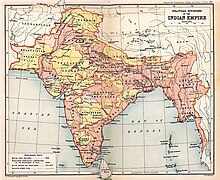
Before it gained independence in 1947, India (also called the Indian Empire) was divided into two sets of territories, one under direct British rule (British India), and the other consisting of princely states under the suzerainty of the British Crown, with control over their internal affairs remaining to varying degrees in the hands of their hereditary rulers. The latter included 562 princely states which had different types of revenue-sharing arrangements with the British, often depending on their size, population and local conditions. In addition, there were several colonial enclaves controlled by France and Portugal. After independence, the political integration of these territories into an Indian Union was a declared objective of the Indian National Congress, and the Government of India pursued this over the next decade.
In 1920, Congress (party) under the leadership of Mahatma Gandhi declared swaraj (self-rule) for Indians as its goal and asked the princes of India to establish responsible government.[1] Jawaharlal Nehru played a major role in pushing Congress to confront the princely states and declared in 1929 that "only people who have the right to determine the future of the States must be the people of these States".[2] In 1937, the Congress won in most parts of British India (not including the princely states) in the provincial elections, and started to intervene in the affairs of the states.[2] In the same year, Gandhi played a major role in proposing a federation involving a union between British India and the princely states, with an Indian central government. In 1946, Jawaharlal Nehru observed that no princely state could prevail militarily against the army of independent India.[3] In January 1947, Nehru said that independent India would not accept the divine right of kings.[4] In May 1947, he declared that any princely state which refused to join the Constituent Assembly would be treated as an enemy state.[5]
Sardar Vallabhbhai Patel along with Louis Mountbatten and V. P. Menon were more conciliatory towards the princes, and as the men charged with integrating the states, were successful in the task.[6] Having secured their accession, they then proceeded, step by step, to secure and extend the union government's authority over these states and transform their administrations until, by 1956, there was little difference between the territories that had been part of British India and those that had been princely states. Simultaneously, the Government of India, through a combination of military and diplomatic means, acquired de facto and de jure control over the remaining colonial enclaves, which too were integrated into India.
- ^ Cite error: The named reference
Sisson Wolpertwas invoked but never defined (see the help page). - ^ a b Cite error: The named reference
o824was invoked but never defined (see the help page). - ^ Menon, Shivshankar (20 April 2021). India and Asian Geopolitics: The Past, Present. Brookings Institution Press. p. 34. ISBN 978-0-670-09129-4. Archived from the original on 14 April 2023. Retrieved 6 April 2023.
- ^ Lumby, E. W. R. 1954. The Transfer of Power in India, 1945–1947. London: George Allen & Unwin. p. 228
- ^ Tiwari, Aaditya (30 October 2017). "Sardar Patel – Man who United India". pib.gov.in. Archived from the original on 15 November 2022. Retrieved 29 December 2022.
- ^ "How Vallabhbhai Patel, V P Menon and Mountbatten unified India". 31 October 2017. Archived from the original on 15 December 2022. Retrieved 29 December 2022.